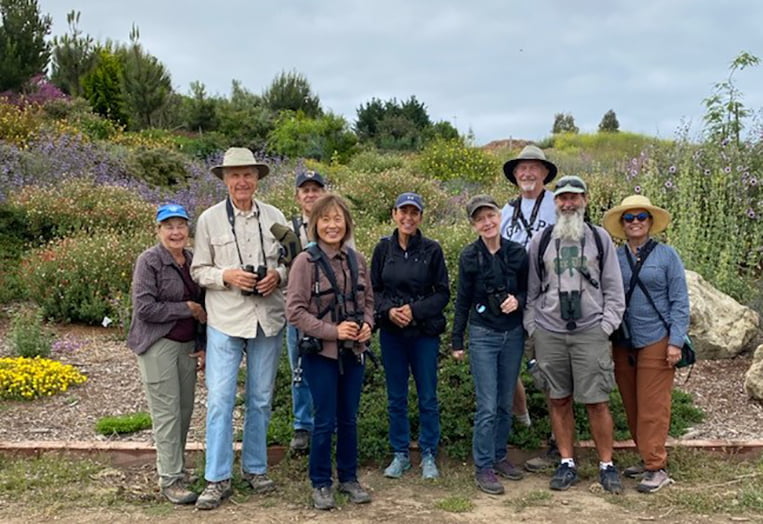
Bird Survey – May 2021
Urban Forest Monthly Survey
June 24, 2021
34 Species
Sharon and Dave Telford, Jim Currie, Lena Hayashi, Barbara Wasbin, Betty Kanne, Jim Kendall, Mark Johnston, and Brenda Sabin (pictured above), enjoyed a slightly overcast, but pleasant, clear and calm day with temperatures in the 60s when they set out in May to count all the birds they could see and hear.
The majority of migrants have now passed through this part of the Pacific Flyway, as evidenced by the drop in the number of species from last month’s survey high of 48, to 34 this morning. The growth and expansion of habitat in the Urban Forest has provided these birds more acreage to find rest and food sources, and to better ensure their success along their journey to reach their nesting grounds.
For us, now is the time to enjoy the absolutely beautiful blooms of countless plants, flowering shrubs and leafed out trees in the Urban Forest. The forever hard-working volunteers must feel so much satisfaction in seeing the fruits of their labor during this season. The colors are brilliant and the experience enchanting. The surveyors couldn’t be more content while counting and studying the resident and visiting birds of the Urban Forest.
The most vocal nesting birds that can be heard throughout the Urban Forest are the House Wrens, California Towhees, Spotted Towhees, Common Yellowthroats, American and Lesser Goldfinches and the non-native Swinhoe’s White-eyes. A Bushtit, mouth filled with fluff and other nesting material, was seen which means a nest is in the making in a nearby tree. The site of the Lesser Goldfinch nest we saw a female sitting on two months ago is now empty and we hope the chicks fledged successfully. Laura, a UF volunteer, will be happy to know the bluebird box she put up was observed with a male and female Western Bluebird going in and out to feed their young. Many Anna’s and Allen’s Hummingbirds were doing their characteristic mating displays and the sound of hummers flying was everywhere! Flycatchers were plentiful. We had 5 Ash-throated Flycatchers, a Western Wood-Pewee, 4 Pacific-slope Flycatchers, 7 Cassin’s Kingbirds and 5 Western Kingbirds, and 7 of our familiar Black Phoebes. We also had 5 Warbling Vireos and a Cassin’s Vireo.
What a joy it was to walk through the Urban Forest in the spring, to be outside and in nature, and see plants and animals celebrate this time to reproduce and show off their beauty. What could be better? Many thanks to Brenda Sabin for keeping the eBird list, Jim and Dave for their photos, Sheila Holliday for posting the results and list, and of course Jean Nagy and her crew!
Checklist S89462341
Sharing links
Main details
Thu 27 May 2021
8:02 AM
Totals
Observations
-
Number observed: 12
Media
© Lena Hayashi Macaulay Library © James Kendall Macaulay Library -
Number observed: 18
-
Number observed: 4
-
Number observed: 14
-
Number observed: 23
-
Number observed: 4
-
Number observed: 1
-
Number observed: 2
-
Number observed: 2
Media
© Lena Hayashi Macaulay Library © James Kendall Macaulay Library © James Kendall Macaulay Library © James Kendall Macaulay Library -
Number observed: 1
Media
© James Kendall Macaulay Library © James Kendall Macaulay Library © James Kendall Macaulay Library -
Number observed: 1
Media
© James Kendall Macaulay Library -
Number observed: 1
-
Number observed: 3
-
Number observed: 2
-
Number observed: 7
-
Number observed: 1
-
Number observed: 1
-
Number observed: 9
-
Number observed: 7
-
Number observed: 10
Details
Observed two active nest boxes, one with bird flying into box to feed (photo) in butterfly gardenMedia
© Lena Hayashi Macaulay Library © Lena Hayashi Macaulay Library © Lena Hayashi Macaulay Library © James Kendall Macaulay Library © James Kendall Macaulay Library © James Kendall Macaulay Library -
Number observed: 1
-
Number observed: 4
Details
male and female observed entering and exiting box feeding youngMedia
© Lena Hayashi Macaulay Library © Lena Hayashi Macaulay Library © James Kendall Macaulay Library © James Kendall Macaulay Library © James Kendall Macaulay Library © James Kendall Macaulay Library -
Number observed: 2
-
Number observed: 1
Details
female -
Number observed: 95
Details
many including young fledged birds -
Number observed: 27
-
Number observed: 2
Details
Pair seen, photo of male. Information has it that they nested in the UF and are now working on a second clutch -
Number observed: 7
Details
Fledgling in a small tree during our observation, neither parent came to feed it. Photos to followMedia
© Lena Hayashi Macaulay Library © Lena Hayashi Macaulay Library © James Kendall Macaulay Library © James Kendall Macaulay Library -
Number observed: 8
Details
singing -
Number observed: 11
Details
calls and song -
Number observed: 1
Details
Unusual vocalization- clear, tonal and fairly long whistle-like note followed by usual pweee ending. Initially thought it was from two different birds but when it flew away, it continued with the two sounds from another location. Syrinx capable of two sounds almost simultaneously… -
Number observed: 1
-
Number observed: 3
Details
singing -
Number observed: 8
Details
song and calls





























Details
female